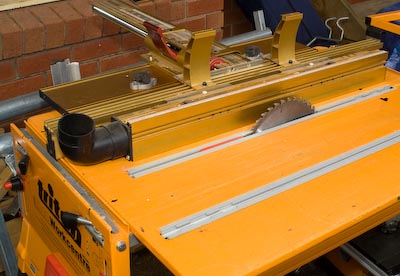It’s been a bit of a day of swinging around heavy items single-handedly. Which I would hesitate to suggest would be quite typical for the majority of woodworkers out there (the single-handedness). Our hobby/passion/obsession is pretty much an individual pursuit – it is rare to have someone else in the workshop with you while you work, and so if there is something heavy to move, “it’s all you baby”.
Today for example, I was mounting the wings on the new tablesaw, and each of those is a good 30 – 40kg. Not too bad to lift (carefully), but it is another matter entirely when you have to be dexterous with them at the same time. That takes a lot of extra effort. I was also hanging the shed doors today, and they are heavy – again 40+kg each, and again it was me, myself and I having to do all the lifting, manipulation and balancing while screwing the hinges home.
It was while carefully manipulating the doors into position that I was thinking of the whole manual handling issue. I’m also a Health and Safety Rep at work, and the stuff I do in the shed would have me issuing workplace reports left and right at work. So why do we tolerate practices at home that would not get a look in, in a commercial environment? In part, because it has to be – if we don’t move that sheet, lift that whatever, who will?
So to my point – it is a matter of working smarter to ensure that what we do in our workplace is sensible.
For example, when I’m working on a project that uses sheet goods (such as MDF), I typically will buy full sheets (2400x1200mm), as that is a lot more cost competitive. What I used to then do, was man-handle them down the back of the property, and swing them onto the tablesaw extension table to rip then down to the required sizes. It wasn’t a good practice, and as much as the bench could take having the sheet on it, it didn’t like how I got the sheet on there (and nor did my back).
So for my next project, I worked out a much more planned cutting list, with plenty of waste allowances, and then processed the sheets as I took them off the trailer. It might have been nothing more than cutting a sheet in half, but that was sufficient.
So give some consideration to your manual handling requirements – to the stock sizes you buy and how you process them. Get them cut down if possible at point of purchase if that is an option. When you have the stock at home, look at your storage issues, don’t store heavy items high etc.
If you need to, get a mate over, or a neighbour to help move something heavy around. It might cost you a beer or two, but it might not cost your back.
***Addendum***Dang, I completely forgot to mention, and as Robert correctly pointed out in the comments (thanks!) INFEED and OUTFEED support! Having some stands is absolutely invaluable.
You can get roller stands, but these have the disadvantage of tracking the material (ie, if they are not absolutely perpendicular to the direction of material travel, they can pull the material into, or away from the fence). There are ones with more of a ball roller which are omnidirectional which are good, and what I have are Triton Multistands

These are height, and angle adjustable, and have slip bars rather than rollers so they don’t track the material. In addition, they have a U section to the top with a clamp, so you can fit a length of 2×4 between two of them, providing side support for the length of the table.

In total, I have about 4 of these – infeed, outfeed and two for side support.***
Filed under: Uncategorized | Tagged: Manual Handling, Safety, Safety Week | 5 Comments »


















